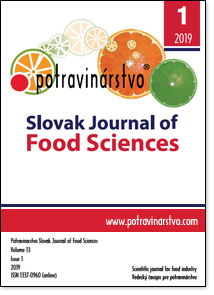Proteomic study of pig’s spleen
DOI:
https://doi.org/10.5219/1093Keywords:
spleen, two-dimensional electrophoresis, pork, proteomicAbstract
This work is devoted to pig spleen proteome study. Spleens were taken from Duroc pigs (females, 145 - 160 days old) and typical two-dimensional electrophoregrams were obtained. On proteomic maps after visualization and image analysis there were detected 600 fractions, including organ-specific proteins - 3 62 fractions. Among the identified constitutive fractions, the highest expression was observed (Vol spots more than 3.0E + 07) four protein spots S1, S9, S12 and S21, which are supposedly Annexin A1 (MW 38.76 kDa), Ectonucleoside triphosphate diphosphohydrolase 1 (MW 57.75 kDa) Pro-cathepsin H CD59 (MW 37.45 kDa) and glycoprotein (MW 13.79 kDa), respectively. Obtained electrophoregrams analysis using information resources made it possible to identify different active compounds in spleen with various functions, mainly immunoregulatory - glycoprotein CD59 (Mm 13.79 kDa) and ATP-dependent RNA helicase (Mm 107.58 kDa); the intensely expressed LIM-domain of the actin-binding protein (Mm 83.99 kDa). The results obtained are a prospect for immunomodulating biologic development based on animal raw materials for farm animals.
Downloads
Metrics
References
D'acquisto, F., Perretti, M., Flower, R. J. 2008. Annexin‐A1: a pivotal regulator of the innate and adaptive immune systems. British journal of pharmacology, vol. 155, no. 2, p. 152-169. https://doi.org/10.1038/bjp.2008.252 DOI: https://doi.org/10.1038/bjp.2008.252
Gladue, D. P., Baker-Bransetter, R., Holinka, L. G., Fernandez-Sainz, I. J., O’Donnell, V., Fletcher, P., Zhiqiang Lu, Borca, M. V. 2014. Interaction of CSFV E2 protein with swine host factors as detected by yeast two-hybrid system. PLoS One, vol. 9, no. 1, p. e85324. https://doi.org/10.1371/journal.pone.0085324 DOI: https://doi.org/10.1371/journal.pone.0085324
Hirano, H. 1982. Varietal differences of leaf protein profiles in mulberry. Phytochemistry, vol. 21, no. 7, p. 1513-1518. https://doi.org/10.1016/S0031-9422(82)85008-5 DOI: https://doi.org/10.1016/S0031-9422(82)85008-5
Huang, J., Zhang, J., Lei, T., Chen, X., Zhang, Y., Zhou, L., Yu, A., Chen, Z., Zhou, R., Yang, Z. 2010. Cloning of porcine chemerin, ChemR23 and GPR1 and their involvement in regulation of lipogenesis. BMB reports, vol. 43, no. 7, p. 491-498. https://doi.org/10.5483/BMBRep.2010.43.7.491 DOI: https://doi.org/10.5483/BMBRep.2010.43.7.491
Chen, X., Wang, X., Li, Z., Kong, L., Liu, G., Fu, J., Wang, A. 2012. Molecular cloning, tissue expression and protein structure prediction of the porcine 3-hydroxy-3-methylglutaryl-coenzyme A reductase (HMGR). Gene, vol. 495, no. 2, p. 170-177. https://doi.org/10.1016/j.gene.2011.12.051 DOI: https://doi.org/10.1016/j.gene.2011.12.051
Chernukha, I. M., Fedulova, L. V., Kotenkova, E. A., Shishkin, S. S., Kovalyov, L. I., Mashentseva, N. G., Klabukova, D. L. 2016. Influence of heat treatment on tissue specific proteins in the cardiac muscle and aorta sus scrofa. Russian Journal of Biopharmaceuticals, vol. 8, no. 6, p. 38-44.
Chernukha, I. M., Fedulova, L. V., Vasilevskaya, E. R., Kotenkova, E. A. 2017. Comparative study of biocorrective protein-peptide agent to improve quality and safety of livestock products . Potravinarstvo Slovak Journal of Food Sciences, vol. 11, no. 1, p. 539-543. https://doi.org/10.5219/590 DOI: https://doi.org/10.5219/590
Kimura, Y., Saeki, Y., Yokosawa, H., Polevoda, B., Sherman, F., Hirano, H. 2003. N-Terminal modifications of the 19S regulatory particle subunits of the yeast proteasome. Archives of Biochemistry and Biophysics, vol. 409, no. 2, p. 341-348. https://doi.org/10.1016/S0003-9861(02)00639-2 DOI: https://doi.org/10.1016/S0003-9861(02)00639-2
Kotenkova, E. A., Lukinova, E. A., Fedulova, L. V. 2017. Antimicrobial compounds of porcine mucosa. In IOP Conference Series: Earth and Environmental Science. vol. 85, no. 1, p. 012068. https://doi.org/10.1088/1755-1315/85/1/012068 DOI: https://doi.org/10.1088/1755-1315/85/1/012068
Lemmens, R., Vanduffel, L., Kittel, A., Beaudoin, A. R., Benrezzak, O., Sévigny, J. 2000. Distribution, cloning, and characterization of porcine nucleoside triphosphate diphosphohydrolase‐1. European Journal of Biochemistry, vol. 267, no. 13, p. 4106-4114. https://doi.org/10.1046/j.1432-1327.2000.01462.x DOI: https://doi.org/10.1046/j.1432-1327.2000.01462.x
Maher, S. E., Pflugh, D. L., Larsen, N. J., Rothschild, M. F., Bothwell, A. L. 1998. Structure/function characterization of porcine CD59: expression, chromosomal mapping, complement-inhibition, and costimulatory activity. Transplantation, vol. 66, no. 8, p. 1094-110. https://doi.org/10.1097/00007890-199810270-00021 DOI: https://doi.org/10.1097/00007890-199810270-00021
Mora, L., Gallego, M., Toldrá, F. 2018. New approaches based on comparative proteomics for the assessment of food quality. Current Opinion in Food Science, vol 22, p. 22-27. https://doi.org/10.1016/j.cofs.2018.01.005 DOI: https://doi.org/10.1016/j.cofs.2018.01.005
Ruiz‐Cortés, Z. T., Men, T., Palin, M. F., Downey, B. R., Lacroix, D. A., Murphy, B. D. 2000. Porcine leptin receptor: molecular structure and expression in the ovary. Molecular Reproduction and Development, vol. 56, no. 4, p. 465-474. https://doi.org/10.1002/1098-2795(200008)56:4<465::AID-MRD4>3.0.CO;2-Q DOI: https://doi.org/10.1002/1098-2795(200008)56:4<465::AID-MRD4>3.0.CO;2-Q
Swiss-Prot database. 2002. [online] s.a. [cit. 2019-01-18] Available at: https://www.uniprot.org/uniprot/?query=reviewed:yes
Wang, H., Wang, H., Zhu, Z., Yang, S., Feng, S., Li, K. 2007. Characterization of porcine EPLIN gene revealed distinct expression patterns for the two isoforms. Animal biotechnology, vol. 18, no. 2, p. 101-108. https://doi.org/10.1080/10495390600864660 DOI: https://doi.org/10.1080/10495390600864660
Xie, L., Liu, M., Fang, L., Su, X., Cai, K., Wang, D., Chen, H. Xiao, S. 2010. Molecular cloning and functional characterization of porcine stimulator of interferon genes (STING). Developmental & Comparative Immunology, vol. 34, no. 8, p. 847-854. https://doi.org/10.1016/j.dci.2010.03.005 DOI: https://doi.org/10.1016/j.dci.2010.03.005
Yang, W., Diehl, J. R., Roudebush, W. E. 2003. Organization of Porcine Platelet‐Activating Factor Receptor Gene. Animal biotechnology, vol. 14, no. 2, p. 177-181. https://doi.org/10.1081/ABIO-120026487 DOI: https://doi.org/10.1081/ABIO-120026487
Yang, W., Diehl, J. R., Yerle, M., Ford, J. J., Christenson, R. K., Roudebush, W. E., Plummer, W. E. 2003. Chromosomal location, structure, and temporal expression of the platelet‐activating factor receptor (PAFr) gene in porcine endometrium and embryos relative to estrogen receptor α gene expression. Molecular Reproduction and Development, vol. 64, no. 1, p. 4-12. https://doi.org/10.1002/mrd.10217 DOI: https://doi.org/10.1002/mrd.10217
Yim, D., Jie, H. B., Lanier, L. L., Kim, Y. B. 2000. Molecular cloning, gene structure, and expression pattern of pig immunoreceptor DAP12. Immunogenetics, vol. 51, no. 6, p. 436-442. https://doi.org/10.1007/s002510050642 DOI: https://doi.org/10.1007/s002510050642
Zhang, X., Wang, C., Schook, L. B., Hawken, R. J., Rutherford, M. S. 2000. An RNA helicase, RHIV-1, induced by porcine reproductive and respiratory syndrome virus (PRRSV) is mapped on porcine chromosome 10q13. Microbial pathogenesis, vol. 28, no. 5, p. 267-278. https://doi.org/10.1006/mpat.1999.0349 DOI: https://doi.org/10.1006/mpat.1999.0349
Published
How to Cite
Issue
Section
License
This license permits non-commercial re-use, distribution, and reproduction in any medium, provided the original work is properly cited, and is not altered, transformed, or built upon in any way.






























